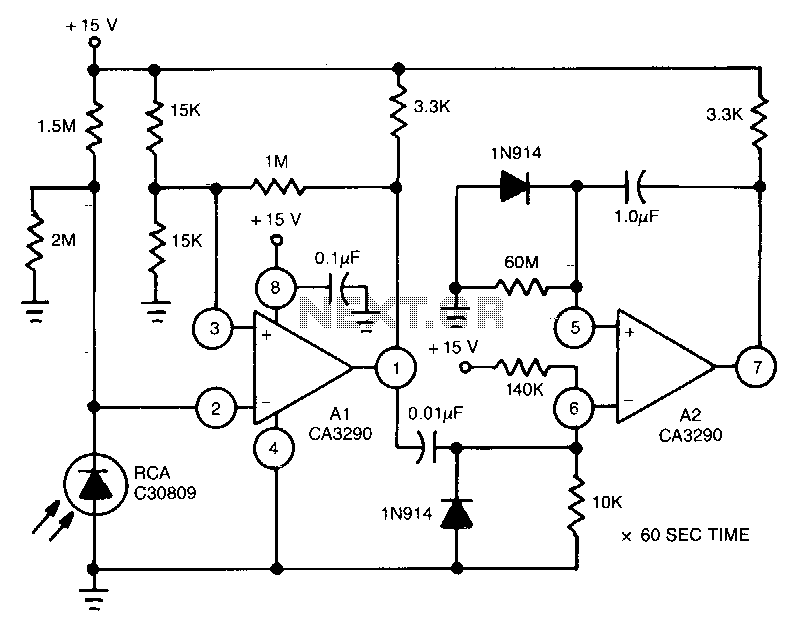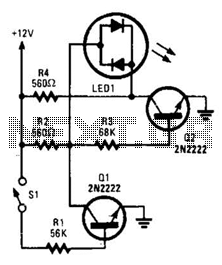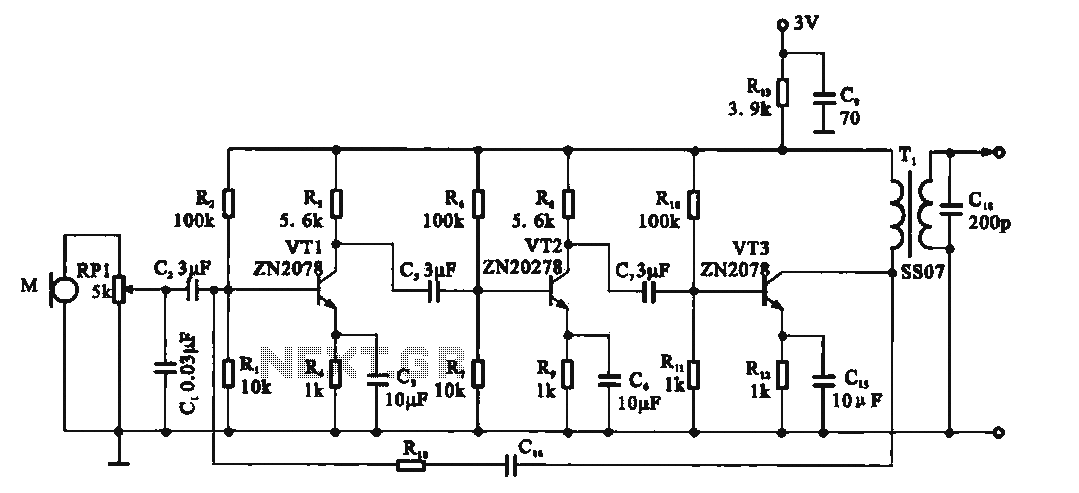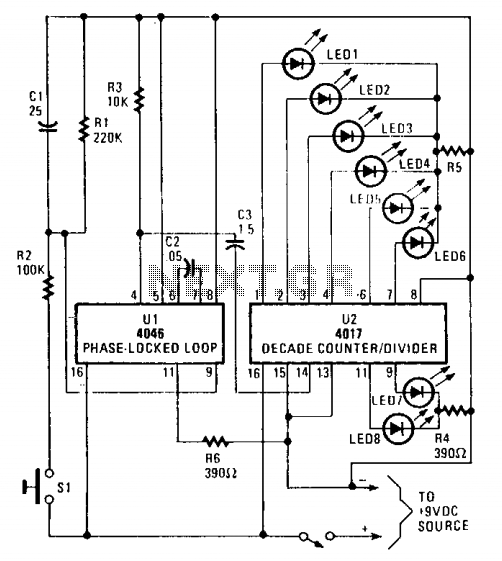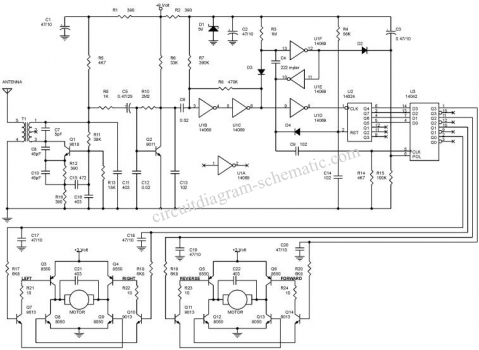
LED Audio Level (VU) Indicator and Alarm: The Dot Turns to Bar When The Signal Reach The Maximum Le
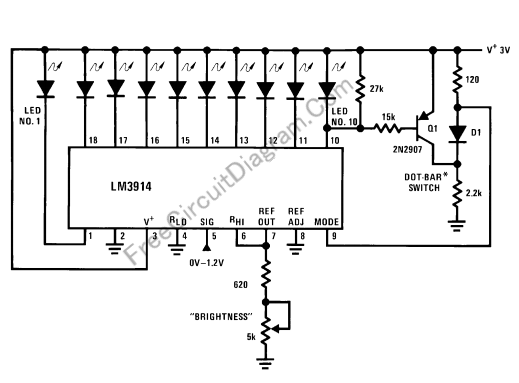
This LED (Light Emitting Diode) display consists of 10 LEDs to indicate the level of an input signal. If the signal is low, only LED #1 will light up. As the signal level increases, the illuminated dot will progress through LEDs #2, #3, #4, and so on. When the input signal drives the dot to LED #9, any further increase will light up LED #10 and activate all preceding LEDs, transforming the dot into a full-scale bar. This provides a clear visual alarm indicating that the maximum level has been reached. The input signal is detected by the chip at pin 5, and it should range between 0-1.2V, which is suitable for standard audio line (line-out) levels. This circuit utilizes the LM3914, which features linear scaling for the LEDs, allowing the indication to move proportionally with the input signal: when the input is at maximum, LED #10 lights up (along with all other LEDs due to the alarm function), and at half maximum, either LED #5 or #6 will illuminate, while LED #1 will light when the signal reaches 1/10 of the maximum. To accurately represent the audio level (VU, voltage unit), the circuit should be fed by the output of a peak detector. Connecting directly to the audio signal would result in a rapidly blinking display with an unclear dot position, as the audio signal oscillates around an equilibrium point. A single transistor peak detector is suitable for this purpose, as the resolution between two adjacent LEDs is slightly more than 100mV. A logarithmic display provides a more representative indication when dealing with audio signals, as humans perceive sound levels logarithmically; a change from 9 to 10 is less noticeable than a change from 1 to 2 in sound wave amplitude. The first change is perceived as minimal, while the latter is recognized as twice as loud, despite both cases representing the same absolute unit change. For logarithmic scaling, National Semiconductor offers an alternative series compatible with the LM3914, specifically the LM3915. Replacing the chip with the LM3915 will yield a logarithmic scale display. However, a more precise peak detector is required for logarithmic scaling, as the display will exhibit greater resolution at lower levels. A precision half-wave peak detector would be suitable for this circuit. With a logarithmic scale indicator, dynamic indications will be evident across nearly all levels of the volume control.
The LED display circuit described utilizes the LM3914 integrated circuit to visually represent the amplitude of an audio signal through a series of ten LEDs. The architecture of the circuit is designed to provide a clear indication of signal levels, making it suitable for audio applications where level monitoring is essential. The LM3914 operates in a linear mode, where each LED corresponds to a specific voltage level within the specified range of 0-1.2V. The circuit's design allows for a straightforward interpretation of audio levels, with the first LED lighting up at minimal signal levels and subsequent LEDs illuminating as the signal strength increases.
To enhance the performance of this circuit, particularly when dealing with audio signals that fluctuate rapidly, a peak detector is integrated into the design. This component captures the peak voltage of the audio signal, ensuring that the LEDs display a stable indication of the signal level rather than a rapidly changing flicker. The use of a single transistor peak detector is recommended, as it provides sufficient resolution to differentiate between adjacent LEDs, which is critical for accurate audio level representation.
For applications requiring a logarithmic representation of audio levels, the LM3915 is a suitable alternative to the LM3914. This chip is pin-compatible, allowing for easy substitution. However, it is important to note that the logarithmic display necessitates a more precise peak detection mechanism to maintain accuracy at lower signal levels. Implementing a precision half-wave peak detector will enhance the circuit's ability to reflect subtle changes in audio amplitude, resulting in a more nuanced and responsive visual indication.
Overall, this LED display circuit serves as an effective tool for monitoring audio levels, providing clear visual feedback that is crucial for audio engineering and performance applications. The choice of components and the design approach ensure that the display remains responsive and accurate across the intended range of audio signals.This LED (Light Emitiing Diode) display consist of 10 LEDs to indicate the level of an input signal. If the signal is small, only LED#1 will light, and if the signal level getting higher then you`ll se the light dot will move through LED #2, #3, #4, and so on. When the signal input drive the dot until LED #9 lights, the next increasing input s ignal won`t only move the dot to LED #10, but it turn on all the LEDs, changing the dot to a full-scale bar. This give you a better alarm to show you that the maximum level has been reached. The input signal is detected by the chip at pin 5, and it should range between 0-1. 2V. This range is suitable for standard audio line (line-out) level. This circuit uses LM3914 which has linear scaling for the LED, the indication move linearly with the input signal: if the input is maximum then the LED#10 will light (and all other LED`s because the alarm fuction is working), if the input is at half maximum then the LED#5 or #6 will light, LED #1 will light when the signal is 1/10 of the maximum.
To show well defined dot position representing audio level (VU, voltage unit) as we percept, we need to feed this circuit using the output of a peak detector. Connecting directly to audio signal would give fast blinking display with vague dot position, since audio signal is actually oscillate between an equilibrium point.
The single transistor peak detector is suitable for this purpose, because the resolution of two adjacent LEDs is slightly more than 100mV. Logarithmic display give more representative indication when dealing with audio signal, since we naturally percept the sound level in logarithmic manner, a change from 9 to 10 is not really noticed as the change from 1 to 2 in sound wave amplitude.
We percept the first one as being almost no change while the last one is twice louder, although both cases show the same one absolute unit change. For the logarithmic scale, National Semiconductor provide other series, with pin-to-pin compatible with LM3914, and it`s LM3915.
Just change the chip with LM3915 and the display will be in logarithmic scale. But wait, you need more precise peak detector for logarithmic scale, since the display will have more precise resolution at low level indication. The precision half-wave peak detector would be suitable for this circuit. Using logarithmic scale indicator, you`ll notice good dynamic indication in almost all level of your volume control.
[Circuit schematic diagram source: National Semiconductor Application Notes] 🔗 External reference
The LED display circuit described utilizes the LM3914 integrated circuit to visually represent the amplitude of an audio signal through a series of ten LEDs. The architecture of the circuit is designed to provide a clear indication of signal levels, making it suitable for audio applications where level monitoring is essential. The LM3914 operates in a linear mode, where each LED corresponds to a specific voltage level within the specified range of 0-1.2V. The circuit's design allows for a straightforward interpretation of audio levels, with the first LED lighting up at minimal signal levels and subsequent LEDs illuminating as the signal strength increases.
To enhance the performance of this circuit, particularly when dealing with audio signals that fluctuate rapidly, a peak detector is integrated into the design. This component captures the peak voltage of the audio signal, ensuring that the LEDs display a stable indication of the signal level rather than a rapidly changing flicker. The use of a single transistor peak detector is recommended, as it provides sufficient resolution to differentiate between adjacent LEDs, which is critical for accurate audio level representation.
For applications requiring a logarithmic representation of audio levels, the LM3915 is a suitable alternative to the LM3914. This chip is pin-compatible, allowing for easy substitution. However, it is important to note that the logarithmic display necessitates a more precise peak detection mechanism to maintain accuracy at lower signal levels. Implementing a precision half-wave peak detector will enhance the circuit's ability to reflect subtle changes in audio amplitude, resulting in a more nuanced and responsive visual indication.
Overall, this LED display circuit serves as an effective tool for monitoring audio levels, providing clear visual feedback that is crucial for audio engineering and performance applications. The choice of components and the design approach ensure that the display remains responsive and accurate across the intended range of audio signals.This LED (Light Emitiing Diode) display consist of 10 LEDs to indicate the level of an input signal. If the signal is small, only LED#1 will light, and if the signal level getting higher then you`ll se the light dot will move through LED #2, #3, #4, and so on. When the signal input drive the dot until LED #9 lights, the next increasing input s ignal won`t only move the dot to LED #10, but it turn on all the LEDs, changing the dot to a full-scale bar. This give you a better alarm to show you that the maximum level has been reached. The input signal is detected by the chip at pin 5, and it should range between 0-1. 2V. This range is suitable for standard audio line (line-out) level. This circuit uses LM3914 which has linear scaling for the LED, the indication move linearly with the input signal: if the input is maximum then the LED#10 will light (and all other LED`s because the alarm fuction is working), if the input is at half maximum then the LED#5 or #6 will light, LED #1 will light when the signal is 1/10 of the maximum.
To show well defined dot position representing audio level (VU, voltage unit) as we percept, we need to feed this circuit using the output of a peak detector. Connecting directly to audio signal would give fast blinking display with vague dot position, since audio signal is actually oscillate between an equilibrium point.
The single transistor peak detector is suitable for this purpose, because the resolution of two adjacent LEDs is slightly more than 100mV. Logarithmic display give more representative indication when dealing with audio signal, since we naturally percept the sound level in logarithmic manner, a change from 9 to 10 is not really noticed as the change from 1 to 2 in sound wave amplitude.
We percept the first one as being almost no change while the last one is twice louder, although both cases show the same one absolute unit change. For the logarithmic scale, National Semiconductor provide other series, with pin-to-pin compatible with LM3914, and it`s LM3915.
Just change the chip with LM3915 and the display will be in logarithmic scale. But wait, you need more precise peak detector for logarithmic scale, since the display will have more precise resolution at low level indication. The precision half-wave peak detector would be suitable for this circuit. Using logarithmic scale indicator, you`ll notice good dynamic indication in almost all level of your volume control.
[Circuit schematic diagram source: National Semiconductor Application Notes] 🔗 External reference
